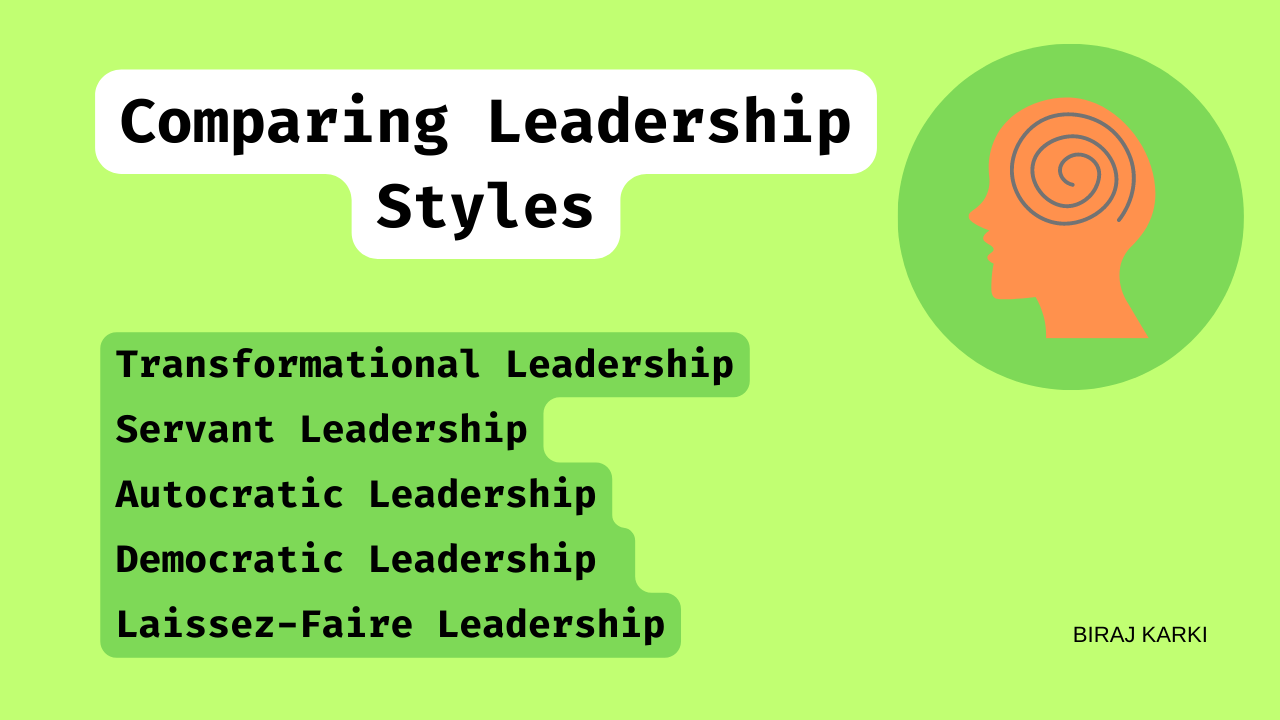Comparing Leadership Styles: Transformational, Servant, Autocratic, Democratic, and Laissez-Faire
 Biraj Karki
Biraj Karki
Leadership is a crucial aspect of any organization, and there are several leadership styles available for leaders to adopt. The most common leadership styles include transformational, servant, autocratic, democratic, and laissez-faire. Each leadership style has its own set of characteristics, advantages, and disadvantages. In this article, we will compare these leadership styles and help you determine which style is best suited for your organization.
Transformational Leadership
Transformational leadership is a style in which leaders inspire and motivate their followers to achieve a common goal. This leadership style focuses on transforming individuals and organizations. The leaders who adopt this style are visionaries and aim to bring about positive changes in their followers and organizations.
Characteristics
Transformational leaders possess several characteristics, such as:
They have a clear vision and communicate it effectively to their followers.
They possess a high degree of emotional intelligence and can understand their followers' needs and motivations.
They are great communicators and can articulate their messages clearly and effectively.
They inspire their followers to reach their full potential and strive for excellence.
They are open to feedback and suggestions from their followers.
Advantages and Disadvantages
The advantages of transformational leadership are:
It leads to high levels of motivation and productivity among followers.
It promotes creativity and innovation.
It improves employee satisfaction and loyalty.
It fosters a sense of community and common purpose among followers.
The disadvantages of transformational leadership are:
It can lead to burnout among followers if the leader's expectations are too high.
It can be difficult to measure the effectiveness of transformational leadership.
It can be time-consuming to implement and maintain.
Examples
Some examples of transformational leaders include Steve Jobs, Nelson Mandela, and Mahatma Gandhi.
Servant Leadership
Servant leadership is a style in which leaders prioritize the needs of their followers over their own needs. This leadership style focuses on serving the people they lead and helping them reach their full potential. The leaders who adopt this style are empathetic and have a deep understanding of their followers' needs.
Characteristics
Servant leaders possess several characteristics, such as:
They prioritize the needs of their followers over their own needs.
They possess a high degree of empathy and can understand their followers' perspectives.
They are great listeners and value their followers' opinions and ideas.
They are committed to personal growth and development.
They create a positive work environment and foster a sense of community.
Advantages and Disadvantages
The advantages of servant leadership are:
It leads to high levels of trust and loyalty among followers.
It fosters a positive work environment and promotes collaboration.
It enhances the personal and professional development of followers.
It leads to higher levels of job satisfaction among followers.
The disadvantages of servant leadership are:
It can be difficult to maintain authority and make tough decisions.
It can be time-consuming to implement and maintain.
It may not be suitable for all situations.
Examples
Some examples of servant leaders include Mother Teresa, Martin Luther King Jr., and Herb Kelleher.
Autocratic Leadership
Autocratic leadership is a style in which leaders make decisions without consulting their followers. This leadership style focuses on maintaining strict control over the organization and its employees. The leaders who adopt this style are authoritative and expect their followers to follow their orders without question.
Characteristics
Autocratic leaders possess several characteristics, such as:
They make decisions without consulting their followers.
They maintain strict control over the organization and its employees.
They are often perceived as cold and distant.
They expect their followers to follow their orders without question.
They focus on achieving results, often at the expense of their followers' well-being.
Advantages and Disadvantages
The advantages of autocratic leadership are:
It allows for quick decision-making.
It is effective in crises.
It can lead to high levels of productivity.
The disadvantages of autocratic leadership are:
It can lead to low morale and job satisfaction among followers.
It can create a culture of fear and distrust.
It stifles creativity and innovation.
Examples
Some examples of autocratic leaders include Adolf Hitler, Joseph Stalin, and Saddam Hussein.
Democratic Leadership
Democratic leadership is a style in which leaders involve their followers in the decision-making process. This leadership style focuses on creating a sense of participation and ownership among followers. The leaders who adopt this style are inclusive and value their followers' opinions.
Characteristics
Democratic leaders possess several characteristics, such as:
They involve their followers in the decision-making process.
They value their followers' opinions and ideas.
They create a sense of participation and ownership among followers.
They foster a positive work environment.
Advantages and Disadvantages
The advantages of democratic leadership are:
It leads to higher levels of job satisfaction and employee morale.
It fosters creativity and innovation.
It creates a sense of ownership and responsibility among followers.
It leads to better decision-making by considering multiple perspectives.
The disadvantages of democratic leadership are:
It can be time-consuming to implement and maintain.
It can be difficult to reach a consensus.
It may not be suitable for all situations.
Examples
Some examples of democratic leaders include Barack Obama, John F. Kennedy, and Angela Merkel.
Laissez-Faire Leadership
Laissez-faire leadership is a style in which leaders give their followers a high degree of freedom to make decisions. This leadership style focuses on creating a sense of independence and autonomy among followers. The leaders who adopt this style are hands-off and trust their followers to make the right decisions.
Characteristics
Laissez-faire leaders possess several characteristics, such as:
They give their followers a high degree of freedom to make decisions.
They trust their followers to make the right decisions.
They are hands-off and provide minimal guidance.
They foster a sense of independence and autonomy among followers.
Advantages and Disadvantages
The advantages of laissez-faire leadership are:
It fosters creativity and innovation.
It allows for flexibility and adaptation to changing circumstances.
It can lead to higher levels of job satisfaction among followers.
The disadvantages of laissez-faire leadership are:
It can lead to confusion and a lack of direction.
It can result in low levels of productivity and accountability.
It may not be suitable for all situations.
Examples
Some examples of laissez-faire leaders include Mahatma Gandhi, Steve Jobs, and Warren Buffett.
Comparing Leadership Styles
Now that we have discussed the characteristics, advantages, disadvantages, and examples of each leadership style, let's compare them to each other.
Transformational and servant leadership styles share some commonalities, such as a focus on personal development and collaboration. However, transformational leadership places more emphasis on inspiring and motivating followers to achieve a shared vision, while servant leadership emphasizes serving others and meeting their needs.
Autocratic and democratic leadership styles differ in their approach to decision-making. Autocratic leaders make decisions without consulting their followers, while democratic leaders involve their followers in the decision-making process. Autocratic leadership is effective in crises and allows for quick decision-making, but it can lead to low morale and creativity among followers. On the other hand, democratic leadership fosters a positive work environment and leads to higher levels of job satisfaction and employee morale, but it can be time-consuming to implement and may not be suitable for all situations.
The laissez-faire leadership style gives followers a high degree of freedom to make decisions and fosters creativity and innovation, but it can also lead to confusion and lack of direction, resulting in low levels of productivity and accountability.
Each leadership style has its advantages and disadvantages, and there is no one-size-fits-all approach to leadership. A good leader is flexible and able to adapt their leadership style to fit the needs of their followers and the situation at hand.
Conclusion
Leadership is a complex and multifaceted concept that has been studied extensively over the years. There are many different leadership styles, each with its own characteristics, advantages, disadvantages, and examples. Understanding these different styles can help individuals become more effective leaders and better understand the leadership styles of others.
Subscribe to my newsletter
Read articles from Biraj Karki directly inside your inbox. Subscribe to the newsletter, and don't miss out.
Written by

Biraj Karki
Biraj Karki
I am Self-taught developer. Currently learning and working in MERN stack and ML/AI.